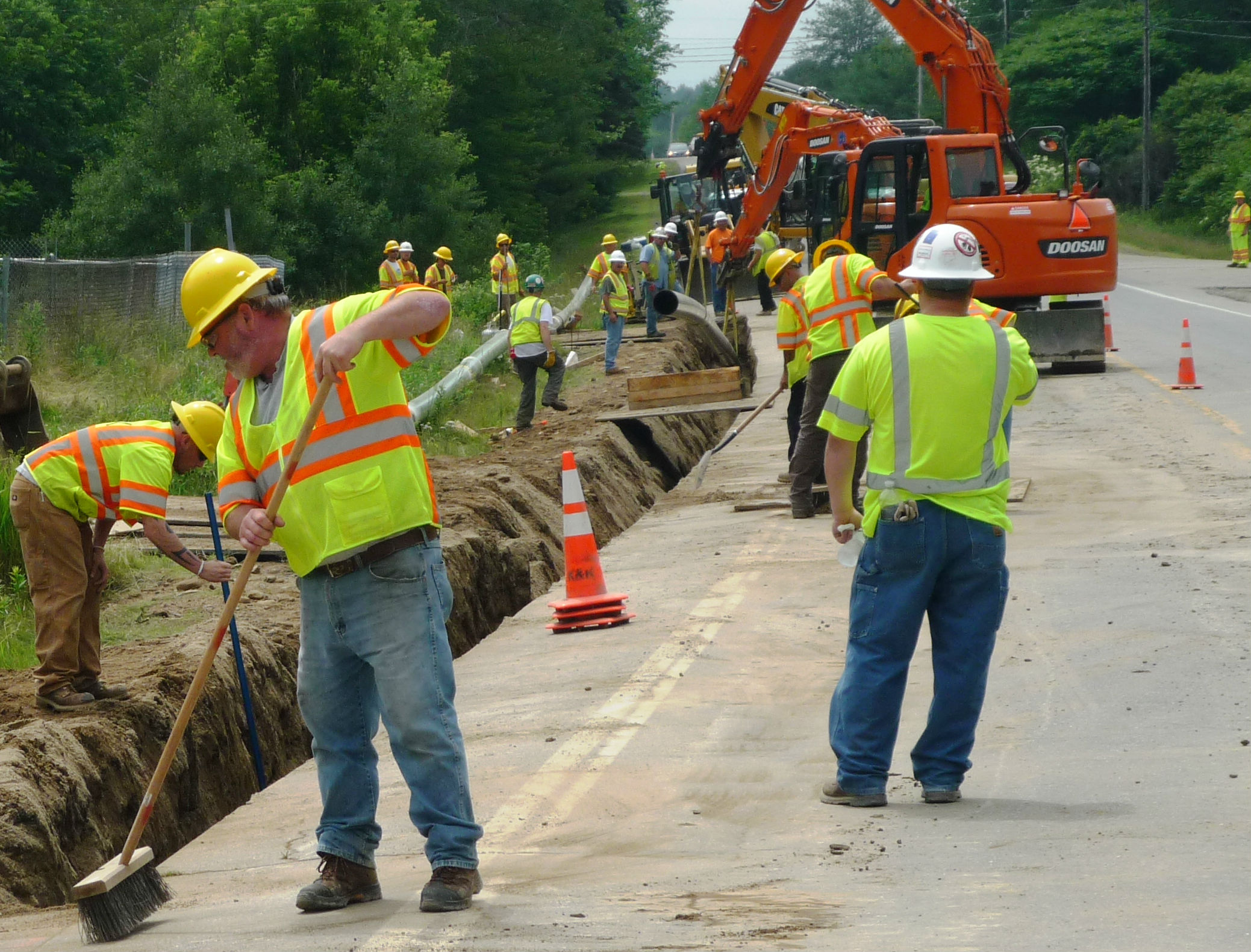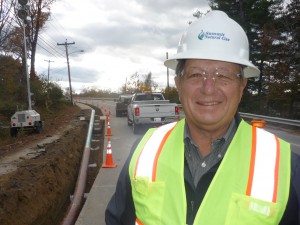June 2014, Vol. 241, No. 6
Features
Summit Build Out Brings Natural Gas To Underserved Maine

In February, when Summit Natural Gas of Maine began providing natural gas to Gardiner businesses and residents who until then had relied on propane or heating oil, it was only part of a much bigger story.
Summit, which specializes in bringing natural gas to underserved communities in the largely rural state, plans to invest $460 million in transmission and distribution projects in the Pine Tree State over the next five years, reaching more than 52,000 customers when the expansion effort is complete.
“We are undertaking something that hasn’t been done for a very long time,” Summit President Michael Minkos told P&GJ. “This is a very large build-out to new areas of Maine.”
In the past year, the company has built out the first phase of its Kennebec Valley project from Pittston to Madison in an effort that included construction of 68 miles of steel main pipeline – 38 miles of that for distribution.
Natural gas service is now available in the communities of Gardiner, Hallowell, Augusta, Waterville, Fairfield, and Madison. Summit will build 153 miles of distribution lines during 2014.
“This project is pretty unusual for New England,” Minkos said, who brings with him over 35 years of electric and gas utility experience. “There aren’t too many brand-new gas distribution companies born in such a short period of time and of this magnitude.”
An especially difficult winter, even by Maine standards, helped to underscore the need for additional natural gas infrastructure throughout New England, even in places that already had distribution. For much of Maine, though, the availability of natural gas would mean a new source of fuel had finally arrived.

“We have gotten a tremendous welcome,” Minkos said. “We are going into three new communities; Cumberland, Yarmouth, and Falmouth this year. The community leaders have been working with us for over a year so people will be able to convert to natural gas as soon as it’s available.”
While also touted as a cleaner fuel, one of the chief selling points for new customers in Maine has been financial savings, which in the case of residential customers may cut bills 30-50%, according to Summit. On the commercial side, where more than 200 commercial customers have already signed contracts with Summit, customers are likely to save up to 30%.
In Gardiner, for example, the local high school, regional middle school and an elementary school will use natural gas as their primary heating source. State assistance helped cover the cost of converting a boiler at each school. The regional school unit estimates savings on heating the schools during the first year at more than $100,000.
In June, the Augusta-based company turned on gas in Waterville with its first customer there, Inland Hospital, estimating its savings of between $100,000 and $150,000 for the first year of service.
Earlier in the year, the city of Augusta started receiving natural gas from Summit in an effort to curb energy costs at 17 city buildings and six schools with expected savings of more than $640,000 annually expected.
The severe winter not only caused hardships for individuals, it also slowed construction on the project, which fell slightly behind projections. Snow and substantial cold weather limited access to roads, and the company ended up drilling in” very small places” in order to have less impact on traffic.
“When you have a schedule that projects you will be someplace by a certain date, that becomes etched in stone in some people’s minds,” Minkos said. “It’s not necessarily understood that when you lose a day to weather you get pushed a little bit further out in the schedule.”
However, he said most future customers have been very understanding, with one telling him, “better late than never.” Minkos added, “This region has waited a long time to have access to natural gas and Summit is proud to bring it to them.”
Summit Natural Gas of Maine, which was incorporated in December 2012, won approval in January to provide service to 17 communities in the central part of the state, along a roughly 20-mile pipeline between Augusta and Winslow that would tap Spectra’s 833,317 MMBtu/d capacity Maritime and Northeast Pipeline.
Summit currently has 66 full-time employees, while the construction effort will employ about 200 contractors, laborers and other workers.
Currently, New England has a shortfall of capacity to serve electric-generation markets, and since the deregulation in the region, there has been no methodology to recover signed-for pipeline demand charges that would allow capacity to be built to service them.
LDCs, which have smaller demands, are contracted for capacity, avoiding exposure to basis differential. In Summit’s case, the company is contracted with a supplier that holds firm capacity and can deliver from the 684-mile Maritimes and Northeast, which went into service in 1999 to transport natural gas from developments offshore Nova Scotia to markets in Atlantic Canada and the northeastern United States.
The Maritimes system consists of a 30- and 24-inch underground mainline running from Goldboro, Nova Scotia through Nova Scotia and New Brunswick to the U.S. border near Baileyville, ME. The pipeline continues through Maine and New Hampshire into Massachusetts, where it connects with the existing North American pipeline grid at Dracut, MA. The pipeline also extends from Methuen, Massachusetts to Beverly, MA.
Minkos, whose experience prior to joining Summit a little more than a year ago, includes overseeing all aspects of the 282-mile natural gas pipeline to serve Maine, Massachusetts and New Hampshire while serving as president and CEO of PNGTS Operating Co., said a number of pending projects should loosen up shipping bottlenecks in the near future.
“The pipelines all want to be able to move the Marcellus gas to the markets, so there are expansions being announced by Spectra, El Paso (Kinder Morgan), Iroquois,” he said. “They all have methodologies for moving the Marcellus gas eastward to their respective pipelines for delivery.”
Numerous such projects are in various stages of competition. Among them:
1. Tennessee Gas Pipeline’s Rose Lake project should be the first to bring capacity to market, shipping 230 MMcf/d to the region beginning in November.
2. Iroquois Gas Transmission’ Wright Interconnect Project (WIP) will enable delivery of up to 667,000 MMcf/d from the proposed terminus of the Constitution Pipeline in Susquehanna County, PA, to Iroquois Gas Transmission and Tennessee Gas Pipeline systems in Schoharie County, NY. Service in planned for 2015.
3. The Portland Natural Gas Transmission System (PNGTS), where Minkos served as president and CEO, expects to bring its Continent to Continent (C2C) in service in November 2016. It will access natural gas supplies from TransCanada Pipeline and transport along it the PNGTS to interconnect with Maritimes and Northeast Pipeline at Westbrook, ME. Completion could bring capacity from the current 173,000 MMcf/d to 359,000 MMcf/d.
4. Spectra Energy’s Atlantic Bridge project, an incremental expansion on Algonquin, and Maritimes and Northeast was announced in February. If all goes as planned, it will be online in 2017 and expand capacity from 103,000 MMcf/d to 615,000 MMcf/d.
5. Tennessee Gas Pipeline’s Northeast expansion will link Tennessee Marcellus receipts with the Iroquois Transmission systems at Wright, NY, linking into New England. The proposed capacity would be 0.6 to 2.2 Bcf/d beginning in 2018.
(Summit Utilities, Inc., the parent company of Summit Natural Gas of Maine, operates 20 natural gas districts throughout Colorado and Missouri, and specializes in providing natural gas to areas that are either hard to serve or that aren’t being served. These districts represent about 40,000 customers, $292 million in assets, 400 miles of high-pressure steel main lines and approximately 1,500 miles of polyethylene main lines.)





Comments